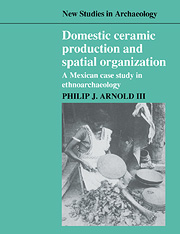Book contents
- Frontmatter
- Contents
- List of figures
- List of tables
- Acknowledgements
- 1 Introduction
- Part 1 Ceramic production and consumption in Los Tuxtlas
- 2 The ceramic production environment
- 3 Ceramic production in Los Tuxtlas
- 4 Ceramic consumption in Los Tuxtlas
- Part 2 Ceramic production and spatial organization
- Part 3 Application and implication
- References
- Index
3 - Ceramic production in Los Tuxtlas
Published online by Cambridge University Press: 02 December 2009
- Frontmatter
- Contents
- List of figures
- List of tables
- Acknowledgements
- 1 Introduction
- Part 1 Ceramic production and consumption in Los Tuxtlas
- 2 The ceramic production environment
- 3 Ceramic production in Los Tuxtlas
- 4 Ceramic consumption in Los Tuxtlas
- Part 2 Ceramic production and spatial organization
- Part 3 Application and implication
- References
- Index
Summary
The previous chapter characterized the Tuxtlas potters as traditional producers operating on a seasonal basis. Minor variability in the production environment was noted (i.e. clays and temper), but other factors such as climate and subsistence activities did not vary markedly between production communities. Despite the separation of potters into two groups, based on time invested in production, pottery manufacture in Los Tuxtlas is essentially an unspecialized, part-time domestic chore.
This overall consistency in production scale and mode, however, is not mirrored by uniformity in manufacturing activities. In fact, the Tuxtlas potters display certain crucial differences in production tools and techniques. These technological distinctions are extremely relevant, for they constitute one of the primary vehicles for interpreting pottery manufacture in the past (also see Stark 1985). Differences in the number and kinds of tools are often associated with very different production systems (Peacock 1982:8–11; van der Leeuw 1984:Figure 1). Firing technology is a case in point; open-air firing is often associated with small-scale production while oven or kiln firing may be symptomatic of more intensive production industries (e.g. Foster 1955:10; Rice 1987:181–182; van der Leeuw 1976:392–398, 1977). Firing differences may also develop to mitigate climatic conditions (Arnold 1985:213). Kilns are of considerable archaeological importance, in that they are more likely to leave discernible archaeological traces than open or even pit firing (Stark 1985:165; also Deal 1988:124).
As the following discussion demonstrates both open and kiln firing are carried out by the Tuxtlas potters.
- Type
- Chapter
- Information
- Domestic Ceramic Production and Spatial OrganizationA Mexican Case Study in Ethnoarchaeology, pp. 35 - 60Publisher: Cambridge University PressPrint publication year: 1991



